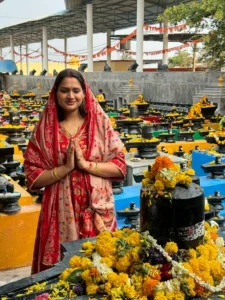India is regarded as a nation with a wealth of spiritual beliefs, traditions and culture. The reason for this is that there are thousands of temples in every city in the nation, some of which are historic, some of which are modern but all of them provide the same sense of serenity and tranquility to the soul.
Temples are special locations where people go to pray, acquire new perspectives or connect with their spiritual side; they are not merely places where Indians go to kill time or have fun. Indian temples are visited by tourists from different nations who want to learn more about the spiritual life of the nation and its customs and ceremonies. Therefore, since temples are revered sites visitors should observe important Temple Etiquettes in India, particularly in Indian temple customs.
Since visiting a temple differs from visiting a public tourist attraction, the restrictions are straightforward and are meant to ensure proper decorum. In India it requires specific temple etiquette. This article offers the top 6 intelligent Temple Etiquettes in India suggestions for visitors which will assist them in adhering to the rules established by the temple’s committee.
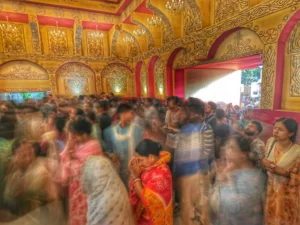
Table of Contents
ToggleFollow Dress Code & Attire:
When entering a Hindu Temple Customs wearing modest clothing is one of the first and most crucial pieces of etiquette to remember. One must cover their legs and shoulders and refrain from wearing anything too exposing regardless of gender. Men can wear respectable long shirts and slacks that completely cover their legs and shoulders. The typical attire of ladies in sarees, salwar kameez and long pants and shirts.
The attire must be appropriate for a temple’s traditional environment. There are Temple Dress Code in India at some temples that must be adhered to. Consult the temple’s website or the rules listed there. It is OK to bring a dhoti for men and a dhupatta or shawl for ladies if one is unaware of the dress code in advance. Men must wear a dhoti to attend certain temples in South India.
Remove Footwear Before Entering:
In India, taking off your shoes before entering a temple is the most important temple etiquette. People can drop off their shoes in a specific location outside the main entrance door on the temple grounds. Since the temple is a hallowed location where people go to pray, it is considered respectful to enter there barefoot.
Maintain Silence and Behave Well:
A temple is a location set aside for contemplation, meditation and prayer. It’s crucial to keep a calm and polite attitude even if a temple may occasionally be alive with chanting and the energy of music. The tranquility of the temple can be disturbed by talking, laughing or answering calls. Additionally it is best to refrain from expressing affection in the temple by giving hugs and holding hands.
In a place of worship something that might seem normal in daily life is disrespectful. In India, visiting a temple is considered respectful if one keeps quiet and behaves well.
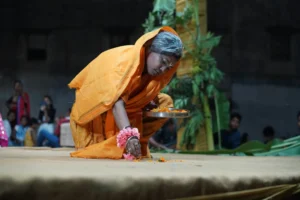
Avoid Photography:
The great deal of painted statues, ceremonial activities and artistically carved pillars make Indian temple architecture incredibly photogenic. There are, however, verbal regulations specific to each temple. While some people are more laid back and don’t mind taking pictures outside others might be subject to rules prohibiting taking pictures within the sanctuary or during rituals.
Perhaps the most crucial thing is to look for signs that make it obvious whether something is permitted or ask a priest or other official for clarification. Since they divert pious people, almost all temples forbid the use of camera flashes or tones. Accepting precious moments is better than taking out the camera lens.
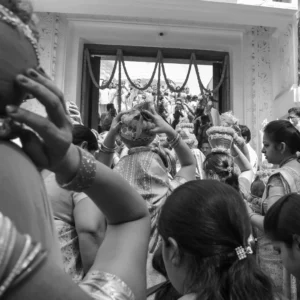
Follow Ritual Norms and Respect Local Practices:
In India, temple rituals, practices and customs vary and are typically more regional and religious. Men and women may even be required to enter through different gates or wait in separate lines in some locations. Prasad a sweet offering should never be accepted with the left hand; instead it should be accepted with the right hand or both hands. It is considered rude to use the left hand.
The same goes for donations made to temples they shouldn’t be carelessly thrown around. Either in the donation boxes or to the temple’s management it should be done with dignity.
Before accessing the inner last section of the temple a few steps must be completed including rituals like ringing a bell, washing hands and lighting a lamp. Take a look around and just follow the actions of those in attendance. When in doubt it is usually polite to bow slightly or join hands in prayer.
Keep Sacred Spaces in Mind and Don’t Touch Idols:
The most sacred area of a temple, the Garbhagriha, is where the main deity is positioned. Temples, as opposed to shrines, are sites of worship where rituals must be carried out. Most temples will advise visitors not to touch the idol but in some specific circumstances, including when attending certain rites, you could be permitted to get a closer look.
Temples are fully operational with priests conducting continuous rituals. You are not supposed to interrupt these. Don’t sit with your feet facing toward the god or holy items, and don’t walk on gifts that have been laid out on the ground. Your admiration for the culture and its Spiritual Tourism Tips is demonstrated by these tiny gestures of attention.
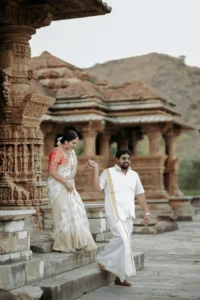
Conclusion
In conclusion, temples have purposes beyond their religious ones. Important monuments, social pillars and manifestations of devotion and spirituality are what they are. Travelers will have a more pleasurable experience if they approach these areas with an open mind and a respectful attitude toward the temple’s culture.Learn more about temple etiquette and religious customs across cultures.
Respecting Temple Etiquettes in India involves feeling the vibrations of a specific location rather than just checking boxes. By means of attentive observation and interaction, you become more than just a visitor to a temple; you become an active participant in the legacy that it represents.
These six well-considered Spiritual Tourism Tips may help you interact more deeply, have a positive influence and possibly return with some peace the next time you are drawn to a temple’s beautiful gopuram or serene sanctorum.

